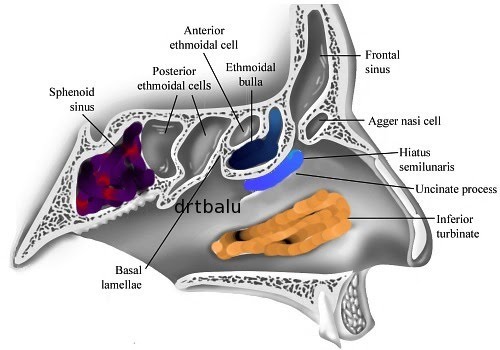Osteomeatal complex
Ostiomeatal complex:
This term is used by the surgeon to indicate the area bounded by the middle turbiante medially, the lamina papyracea laterally, and the basal lamella superiorly and posteriorly. The inferior and anterior borders of the osteomeatal complex are open. The contents of this space are the aggernasi, nasofrontal recess (frontal recess), infundibulum, bulla ethmoidalis and the anterior group of ethmoidal air cells.
This is infact a narrow anatomical region consisting of :
1. Multiple bony structures (Middle turbinate, uncinate process, Bulla ethmoidalis)
2. Air spaces (Frontal recess, ethmoidal infundibulum, middle meatus)
3. Ostia of anterior ethmoidal, maxillary and frontal sinuses.
In this area, the mucosal surfaces are very close, sometimes even in contact causing secretions to accumulate. The cilia by their sweeping movements pushes the nasal secretions. If the mucosa lining this area becomes inflamed and swollen the mucociliary clearance is inhibited, eventually blocking the sinuses.
Some authors divide this osteomeatal complex into anterior and posterior. The classic osteomeatal complex described already has been described as the anterior osteomeatal complex, while the space behind the basal lamella containing the posterior ethmoidal cells is referred to as the posterior ethmoidal complex, thus recognising the importance of basal lamella as an anatomical landmark to the posterior ethmoidal system. Hence the anterior and the posterior osteomeatal complex has separate drainage systems. So when the disease is limited to the anterior compartment of the osteomeatal complex, the ethmoid cells can be opened and diseased tissue removed as far as the basal lamella, leaving the basal lamella undisturbed minimising the risk during surgery.
